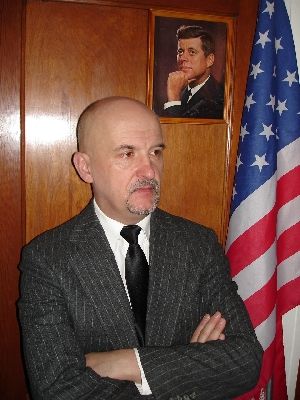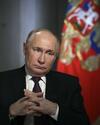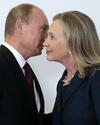"HOW I ELECTED TRUMP". Mikhail Kryzhanovsky, KGB and CIA
Монография / ПолитикаАннотация отсутствует
Объем: 0.892 а.л.
Mikhail Kryzhjanovsky, a former KGB and CIA "Filament"
kryzhanovsky7777@gmail. com
New York



I don't know how Trump got this instruction – it's been written at CIA request back in 1996. Ask Mike Pompeo.
HOW TO WIN PRESIDENTIAL ELECTIONS
By Mikhail Kryzhanovsky
These instructions were written for KGB in 1987, updated for CIA in 1996
1. 1 Get Ready
Before you make a decision to run for President, you must determine for yourself if you can handle the Oval Office: Are you willing to accept such a huge responsibility and put the rest of your life on hold? Are you skilled in dealing with big groups of people? Can you motivate the nation to action? And repair about your biography, which is, of course, not perfect.
Then you must:
1. Decide how are you going to impress party leaders.
2. Make intensive preliminary polling to determine your chances.
3. Poll big demographic groups as well as smaller groups of people from selected demographic groups.
4. Determine the rationale for your candidacy. What is your political record?
5. Delay announcing your candidacy until late in the year before the election to minimize expenditures and risk, avoid legal spending limits, avoid voter fatigue, avoid getting involved in unnecessary controversies and contradictions.
6. Carefully study applicable election laws before you start fundraising and spending.
7. Write your campaign plan (strategic objective, tactical targets, key message, target audiences, methods of delivery, timing, your progress evaluation — polls).
8. Learn the political and economic issues and develop your campaign message.
9. Prepare the “speech” and the “book” (the “speech” is the standard speech that you deliver and it should answer the most important question — why are you running for President; the “book” contains the message and all possible questions on your program.
10. Take a benchmark poll – it will provide the road map for your campaign.
11. Establish your strategy and message
12. Study the results, polls and “successful” areas of previous election.
13. Establish a perfect graphic look (image).
14. Develop a fundraising plan, put the fundraising team in place and start asking for money. No money – no campaign.
15. Create a personal contacts pyramid (priority and general contacts) because personal popularity is your starting point.
16. Set up offices.
17. Get professional candidate training.
18. Determine the focus of your presidential policy (taxes, crime, education, health, social security, national security).
1. 2 Working with the Staff
Basic campaign staffers include:
1) campaign managers — they plan the campaign, organize and recruit the staff, supervise daily campaign operations, make priority contacts with key special groups big business and big media, correct the strategy and make quick decisions. It has to be someone you trust completely.
2) campaign consultants-specialists in both direct (personal and public meetings) and indirect (media, advertising) campaigning
3) strategists
4) analysts
5) issues researchers
6) speechwriters
7) lawyer (interprets election and campaign reporting laws)
8) personal assistants (work on issues in foreign and domestic policy in cooperation with the whole team).
9) fundraisers (plan and execute fundraising events — dinners, parties, auctions, direct appeals through telephone and letters, receptions, computerized fundraising). Big business has to be approached by rich fundraiser only.
10) scheduler (determines events and locations — TV and radio talk shows, news — conferences, meetings with students and professors at college campuses and with professionals at their associations’ annual meetings, special events and fundraisers especially with ethnic leaders in big cities, as well as festivals and big shows where celebrities demonstrate their support, large extravaganzas, meetings at civic clubs, farm warehouse auctions and special auctions, local civic events. Also, scheduler makes arrangements with local media before your visit and sends media the copies of your speech; insures that good crowd will attend the event and takes care of transportation arrangements). The purpose of the campaign planning and strategic scheduling is to draw press attention to the candidate for transmission to the voting public. That’s natural — the candidate who has enough media attention has much better chances of recruiting public acceptance and raising campaign funds.
11) image makers – political consultants who sell your public image as a clear, simple, portrait-like characterization, acceptable to all groups.
12) “hit men” – campaign consultants who are experts on negative advertising, designed to “kill” your opponents.
13) field staff (in target cities mostly). The most important person at any local office is the coordinator — he establishes organization and contacts influential people and political activists. Coordinators must be appointed to each special interests group (women, minorities, unions, college students, public interest activists, the professionals)
14) local volunteers are needed to work in the offices and the streets. Your family has to take an active part in your campaign, too. Your wife and kids are your visual image makers
15) running mate
During the “invisible primary” which is the nomination, campaign you have to make visits to party organizations especially in pivotal states, such as the above mentioned Iowa and New Hampshire where you have to make as many handshaking and personal contacts as possible. Key staffers must travel with you.
1. 3 Fundraising
You are the #1 fundraiser yourself. You must have substantial financial support to compete. You must have an overall plan which outlines expenditures month by month. It is imperative to have even more money on hand at the end of the campaign for an advertising blitz when the voters are most attentive and the field of candidates has been winnowed out. Half of a campaign funds go to media.
Failing to do well in early caucus and primary contests means more than losing delegates — it means that contributions stop.
Your speeches have to be a fun, and match the meal and drinks — don’t be heavy and too political. Actually, you have to run two campaigns (a political campaign and a fund-raising one) and you must win both; if you raise less money than your opponent, you lose, because you don’t have enough money to inform, influence, and motivate your voters. If you are a Senator or a Congressman, you already have an advantage in money (free postage on mail sent to your constituents, automatic media coverage) and you can use your congressional staff to assist your campaign. Besides, you are interviewed by reporters for free as an elected official. You can also ask your political party for a contribution to your campaign. Party money can be given in two ways – as a “direct” contribution or as a “coordinated” expenditure. Direct contributions are funds given by the party to candidates to do with as they please. Coordinated expenditures are made for such services as polling and TV advertising, but the party has a say how the money is spent.
Then you have to ask PACs (political action committees) to fund your campaign, too. PACs are special-interest groups which consist of people who pool their money in order to contribute it to candidates or political party committees who share their political, social, religious or economic views.
To finish well in pre-nomination popularity contests (“straw polls”) you have to appear daily in TV ads, and prime-time news coverage — after the primaries media “label” winners and losers and that affects voters and contributors a lot. Media, especially the most influential “the New York Times” and “Washington Post” (their publications influence decisions on which news stories will be carried on TV channels), have to take you as a very serious contender.
The key rules in fundraising are:
– find some “fat cats, ” quick
– get fundraisers with lots of rich friends
– get money from those who usually contribute
– go to new York, Florida, California, Texas
And the most important strategy is to raise big money for yourself and prevent big money from being spent against you. Early fundraising is crucial to a campaign because of the high costs organization and the need to demonstrate viability. The best states for fundraising are California, New York, Florida, Texas, which supply half of all campaign donations. Go right ahead and raise money in New York and spend in Iowa and New Hampshire.
1. 5 The Press
The press officer (contacts media, takes care of newspapers, radio and TV ads) — the person who markets you — is the boss of advance team that takes care in each state of a total exclusively positive press coverage. To my mind, the best choice for this position is a former journalist with good wide connections to media. He prepares press releases and press kits and schedules interviews and press conferences with the positive vision and attitude reporters (press or media kits contain your photos, a brief biography, campaign position papers, printed brochures and names of contacts for additional information).
The technique in good paid advertising is to go with those ideas, arguments, thoughts, themes and believes in which people are already inclined to believe or ready to accept. There’s no difference between commercial and political advertising — you just substitute a car or shampoo for a human being. Modern presidential campaigns center on “media events” — staged public appearances, during which reporters can talk with you and take pictures (if you have too much money, you can organize media wave — a very large amount of political advertising on TV). Then, the “walking tours” must be scheduled when you, followed by reporters, photographers and TV crews visit potential supporters.
Simultaneously your aide sets up press conferences, selects interviews, and background briefings. You have to talk to press 24/7 and everywhere on the campaign bus, train or plain, hotel, etc. A good thing is — you get free media coverage and people trust it more than paid coverage, like TV and radio commercials.
You win if you obey these rules:
– if you can manipulate media – you manipulate the nation (sorry, it’s harder to manipulate free coverage).
– the media makes the election, not the voters
– a presidential campaign does not allow for privacy
– newspapers put emphasis on issues, TV on image, style and ability to communicate.
– never lie to reporters; they will make sure it backfires on you sooner or later.
– if an influential newspaper, radio or TV station endorses you, you have their supporters, readers, listeners and viewers.
– people remember much better what they see, not what they read; if they don’t see you on TV, you don’t exist.
– TV talks to 98% of Americans and takes your message — and other messages about, or against, you – immediately, straight to the nation.
– TV, not your political party, is the #1 channel of communication between you and the public
– your political party is nothing but a service center and a money machine. Parties divide the nation while your message has to be one of unity.
– take it seriously if The New York Times takes your opponent seriously.
– it’s important to know what your opponent is saying to reporters privately, “not for attribution. ”
– if you live in heavily populated state, like New York, California or Texas, you start the presidential election campaign with much better coverage.
– never fight the media like the Nixon administration did – they kept a list of Nixon’s critics (famous reporters), so they could be targeted for harassment, accused of income tax evasion, etc. What happened then? The reporters felt like heroes, Nobel Prize winners. Better target them for buttering up, and feed them lots of stories with a spin in your favor, instead.
1. 6 Polls
Pollsters works through newspapers, Internet, telephone surveys, person-to-person surveys, mailed questionnaire to selected voters. They provide voters' behavior research and analyze past election data. They tell to you how well-known you are, how well you perform, what are the voters’ preferences. You should poll voters in each state in proportion to that state’s share of the national vote. (You must have at least one polling company on payroll. ) Polling is of extreme importance in presidential campaign because it’s the tool to correct your strategy, determine “positive” local areas and supportive voters and work with them, it tests the nation’s attitude to your personality and your issues and that means you can calibrate your message and calculate your success. The most important thing about polls is that they play indicator and identify support or hostility. And the golden rule here is: you have to ask the right question if you want to get a useful answer.
At the same time polling is one of the most expensive elements of a modern campaign because now you have to receive information on too many groups and issues, including groups with specific economic, ethnic, religious, geographic, educational, occupational and residential characteristics and how those characteristics affect attitudes about a wide range of policy issues.
Polls also help you:
– to decide whether to run or not
– improve your recognition and image
– target opposition’s weakness
– formulate media ads
Your pollster has to pinpoint blocks of voters (swing districts) who are undecided and who might be persuaded to vote for you. Experience shows that 40% of public attention go to social problems, 40% — to economy and 20% — to international matters, but if the United States is at war, the situation is different and national security turns into a top priority for everyone. And watch out for campaign spies — keep polls analysis and media plan secret.
Practical polls:
“Benchmark” – surveys of the whole nation which provide basic information about your chances and the nation’s political preferences (it’s your “presidential decision maker”).
“Follow-up” – surveys are used to gather more data about particular concerns raised in initial benchmark surveys. They are conducted state by state and are used in planning campaign strategy.
“Panel” – surveys are used to refine strategy further by re-interviewing previous respondents to determine opinion shifts on specific issues within various demographic categories. They are supplemented by continuous “tracking polls” that measure fluctuations in general voter support for the candidate across time.
“Special group” – used to poll the debate results. Selected groups of voters watch candidate debates and register their “positive “ or “negative” feelings toward the candidate’s specific statements or actions. After that analysts tabulate and analyze the reactions of the whole groups.
1. 7 Campaign Golden Tips
Never behave as if you think you are God’s gift to the nation.
Be presidential – look calm, sincere, knowledgeable and open Mother of the nation.
Be electable – prove to the nation that you are the best choice.
No one has ever been elected the US President without winning the New Hampshire primary.
Primaries direct financial backers to a promising candidate.
Voters judge you by your friends – appear with popular politicians, big business, labor and interest groups leaders, and show business celebrities. Advertize your meetings with Congress members and world leaders (go abroad if you have a chance to meet a world leader).
The most important event in the election process is the National Convention, not only because the eventual finalist candidate is actually nominated but because after that the campaign’s audience increases (more than twice as many people vote in general elections as participate in the nomination process). You have to decide how to win the support of these new voters as well as to appeal to people who identify with the other party and partisans who backed losing candidates for the nomination.
1. 8 Choosing a strategy
Any strategy is good if it helps you to win support of a majority of people chosen by the state parties to be delegates to the national convention. Your choice of a strategy depends on your current position:
A. If you are an incumbent, you have to stress that the American people’s life improved a lot during your first term. You can count on successful start because you are guaranteed to be known actually to every American, and the Oval Office lends you credibility and respect. It’s of vital importance to have economic accomplishments — in such a case well-timed announcements of government statistics on the economy or of plans for domestic initiatives can also help you. Listen, I didn’t tell you this, but you have to manipulate (stimulate) the economy during the election year with tax cuts that can help reduce unemployment, and with social programs financing.
Of course, you’ll have to pay for it, but that will happen after you are re-elected.
And a good thing is – an improved economy erases voters’ bad memories of past years.
Try to avoid too aggressive campaigning – it’s a sign of weakness. Make official appearances in carefully controlled settings. Influence media coverage with official presidential actions and use “pork barrel” politics to appeal to specific constituents. You can also benefit from the nation’s reluctance to reject a tested national leader for an unknown newcomer. And if you start important foreign policy initiatives, it will guarantee you continued media coverage.
If you have poor chances to be re-elected, you can play the “national security” card:
– find a US “enemy”
– start a media psychosis (see propaganda tricks and brainwashing )
– concentrate power (special services) to establish a total legal control on the nation
– provoke an international conflict, restricted or full-scale war
– send a message: “If you are against the President, you are against America! ”
B. If you are a challenger you have to convince the public they don’t live better than they did 4 years ago, or, if the economy is OK, point out mistakes that were made in the foreign policy. Or make up some social issue that will get passions inflamed and hijack the headlines.
KRYZHANOVSKY ”GOLDEN” STRATEGY
You should seek to position yourself as close to the opposing candidate as possible in an effort to capture the “median voter” in the center, and then take by default everyone else on their side of the ideological spectrum. You have to embrace this strategy and move as close as you can to the moderate Republican position with the expectation that you can take all of the votes to the left of this position. Clear?
The job is tough if you challenge a President who is popular — first, you have to break down his positive image; second, you have to portray yourself as a much better replacement. You have no choice but to start with the “outsider” strategy — you present a “fresh face” to voters weary of the current political situation (in such a case you have to attack administration in a very aggressive manner). Plus, you must give quick response to your opponent’s charges (get advance copies of his speeches through friends in the media).
Then, show yourself as a smart and diplomatic person using a special “triangular” strategy, when you, like majority of the voters, place yourself between liberal and conservative positions. Evaluate situation – you may need “early knockout, ” when front-runners hope to use their early strength in polls, fundraising and endorsements into decisive primary victories at the beginning of the primary season. The hope is that the candidate will build such an impressive early lead that the competition quickly drops out.
A “shift” is the most popular thing with challengers – if the President is good with national security, they point out to the problems in economy, if he’s good on the economy, they point out to the problems in national security – very simple. (Watch his mistakes anyway – you can benefit from them. Bill Clinton would never have run for President in 1992 if someone from the Bush White House hadn’t called him in 1990 and asked him not to run. That phone call was one of the most stupid political moves of the 20th century, because it convinced Clinton that they thought he had a good chance to win.
Be simple, identify with “ordinary people” and no matter what tell the voters your parents or your grandparents “were like them – regular people, not millionaires. ”
1. 9 "Black" PR
You must know some very popular and efficient dirty tricks, like “negative campaigning” or “black" PR. To make a long story short: no matter what your opponent says or what decent people think about negative campaigning — “black PR” works! Use it to turn a rumor or a fact into a serious political scandal; respond to and neutralize the opponent’s attacks (using “black PR”) fast, before they are broadcasted or published.
It works best through intermediates (persons and organizations not connected directly to your campaign). You must have a very detailed file on your opponent (negative research) and then start spreading negative and all kinds of compromising data from his personal and political life. If he is or was elected official (Senator, Governor, Mayor), you can point out his mistakes and actions which were not popular. People must know in detail (get your staff to read a few books) the negative sides of his life, program and terrible consequences of his election. Remember also that a rumor repeated twice turns into a fact, especially if you start a “whispering campaign” in Congress.
A “negative ID” trick is my favorite: you identify your opponent with a totally unacceptable (for the voters) viewpoint, like: “There are those who want to stop the war on international terror and you know who they are! ”
1. 10 Attention : debates!
Debates are extremely important because they offer the only all-national event at which candidates can be judged. You and your opponent will be under huge stress as you both must operate simultaneously at the focus of attention of each other and of all elements of electorate. Debates are, actually, head-to-head confrontations with two main aspects: the pre-debate negotiations over whether there will be a debate, and the post-debate analysis of who did how well. The debates offer nothing new for the public and the basic strategy is to hope your opponent will make a mistake (President Ford made one in 1976, saying that: “There is no Soviet domination of Eastern Europe. ” People just didn’t want to hear it. Richard Nixon was very wrong in 1960 trying to debate on substance, while his opponent, John F. Kennedy, concentrated on style and on presenting the correct presidential image).
While preparing for the winning debates you must:
– have a detailed file on your opponent and study all his speeches and statements; ask yourself: “What does he have that
that I don’t have? ”
– train to answer all possible questions
– be ready to demonstrate deep knowledge of issues and your presidential bearing to a nationwide audience
– repeat your message but keep in mind that image is more important than ideas while you debate — people want to see your good looks, good clothes and nice smile.
And here are the debating “Don’ts”:
Don’t attack first — that’s a sign of weakness.
Don’t be over-polite — a little showmanship appeals to voters.
Don’t be too aggressive — it will ruin your image as a future President.
Don’t answer the questions too fast — that implies you are not thinking.
Don’t rush, no negative emotions, no sudden gestures (extra gestures mean that you are not sure what you are saying is correct).
Don’t disappoint people — speak in a clear and simple way.
And you restrict your influence if you sit.
Follow the rules :
No anxiety reactions – speech errors, moistening of lips, perspiring, shifting eye movements, body jerks. Gesturing with fingers apart communicates weakness, while gesturing with fingers tightly together communicates power.
Look at your opponent with intense concentration – it gives the attitude of command and comfort of the situation.
Answer a question you want to answer, no matter what question was asked.
If you give better answers, you are the better candidate.
Immediately after the debates your press officer has to give the media his biased impression and explain why you won the debates. Your pollster has to watch the polls results.
Tricks
1. Intruding into an opponent’s physical space.
Attempted by: Al Gore, 2000
Result: Failure
When Al Gore tried it in a rehearsal debate, his advisors cautioned against it. It looked awkward. It could come off as too aggressive. The risk was simply too great.
Al Gore decided to do it anyway: The vice president, all stocky 6’3” of him, was going to attempt to physically intimidate George W. Bush.
It was the last in a series of unforced errors Gore made in the debates of 2000 (the audible sighs, the pronounced eye-rolling while Bush spoke). Roughly ten minutes into the third and final debate, a townhall-style affair, Gore sloughed off his stool, a scornful look on his face as he saddled up to Bush’s side while the Texas governor spoke.
Bush responded not with surprise or fright, but with a quizzical look and an offhand nod of acknowledgment, turning back to the audience as the crowd laughed and he continued on with his spiel. Gore’s would-be power move had exactly the opposite effect: instead of looking dominant and in-charge, he seemed awkward and inauthentic.
2: Keeping your opponent in the shot, unaware
Attempted by: Bill Clinton, 1992
Result: Success
We take it for granted now, but the townhall debate is a relatively recent addition to the menu of presidential debate formats. It made its debut in 1992, its structure reflecting the style of the daytime talkshows that dominated the era’s airwaves: Donahue, Sally and Oprah.
Bill Clinton’s campaign lobbied to get the townhall format included in the 1992 fall debate lineup. Looking back, it’s easy to see why: the format plays well to his strengths, providing an opportunity to underline his natural charisma and easy folksiness.
It also created an opportunity for a very media-savvy campaign. Ahead of the debate, Clinton and his team carefully choreographed the candidate’s movement around the stage, working with producers to understand the camera placement. Clinton campaign wanted to “keep one or the other of his competitors in the camera shot at all times, a maneuver that circumvented the prohibition on cutaway [shots] of one candidate while another was speaking. ”
The result was that whenever Clinton was in shot while Bush or Perot spoke, he made sure to look stoic and thoughtful. Perot and Bush, on the other hand, were often caught unawares in the background of Clinton shots, including this oddly checked-out moment from the incumbent—underscoring the difference with the more telegenic Clinton.
3: Swapping out the debate’s stools.
Attempted by: Bill Clinton, 1992
Result: Success
In that same debate, one reason Clinton looked so at-home on stage is because the candidates were actually using the exact same stools that Clinton had rehearsed on. Reportedly, the Clinton campaign switched them onto the set without the permission of the debate’s hosts—and without anyone noticing. Paul Begala, a senior advisor to the campaign, later explained their rationale: “We wanted Gov. Bill Clinton to be completely at ease in his surroundings, right down to his butt. ”
It worked. The stools were far too tall for diminutive billionaire Ross Perot, who uncomfortably leaned against his chair for much of the debate. And while the chairs were the right height for Bush, the president often looked unsure of how to perch on a bar chair while looking confident and presidential.
4. Holding on to a handshake for too long
Attempted by: George H. W. Bush, 1988
Result: Success
In 1988, at his debates with Massachusetts Governor Michael Dukakis, George H. W. Bush shook the governor’s hand for an unusually long time. Ever since, it’s been the source of speculation: was the long handshake an intentional move by Bush, meant to emphasize how taller he was than Dukakis, or was it just a handshake that we’re reading too much into?
Regardless of whether it was intentional, it certainly showed viewers that there was a substantial height difference between the two men (Dukakis is 5’8” and Bush is 6’2”, a full six inches taller). On “Saturday Night Live, ” Dana Carvey’s Bush was shown shaking the hand of Jon Lovitz’s Dukakis, patting him on the head like a child before Dukakis headed to his lectern, where a mechanical lift hoisted him to a respectable stature. Without the awkwardly long handshake in the real debate, it’s quite possible that their height difference never would have been noticed.
5. The ambush handshake
Attempted by: Ronald Reagan, 1980
Result: Success
For the first 20 years of televised debates, it was not commonplace for the candidates to shake hands with each other—the debates started after the candidates were already onstage at their lecterns.
That changed in 1980—unilaterally. In their lone debate that fall, right before the cameras started broadcasting, Jimmy Carter and Ronald Reagan entered the stage from opposite wings and headed straight to their respective microphones, as was tradition. But while Carter stopped at his lectern, Reagan continued to stride across the stage, surprising Jimmy Carter by shaking his hand. Reagan seemed in command from that moment forward.
“Carter’s look of surprise suggested that he thought he was about to be knifed, ” wrote Kathleen Hall Jamieson. “The handshake was as lethal. How could Carter then cast a smiling hand-shaker as a mad bomber who would destroy Social Security, the environment, and perhaps the world? ”
Reagan repeated the gesture at the end of the debate, surprising Carter yet again—this time, televised. It made Reagan look amiable and in charge; Carter looked weak by comparison.
6. The unexpected audience member
Attempted by: John Edwards, 2004
Result: Unclear
In a famous incident on the floor of the U. S. Senate in June 2004, Vice President Dick Cheney told Vermont Democrat Patrick Leahy, “go f—k yourself, ” after the senator had accused Cheney’s former employer, Halliburton, of war profiteering.
So when it came time for the vice presidential debates that October, Senator John Edwards (D-NC) had a plan to get inside Cheney’s head during the debate: He reserved a seat for Leahy in the second row of the debate’s audience, where Cheney would almost certainly see him.
Cheney’s debate performance was characteristically reticent, though it’s unclear what, if any, role Leahy’s seat played in rattling him up. Reportedly, after the debate finished, the Bush-Cheney campaign called the Kerry-Edwards team to complain about the move.
7. The derisive prop
Attempted by: Negotiators for both Dan Quayle & Al Gore, 1992
Result: Détente
Every presidential debate is the topic of high-stakes negotiations by the campaigns involved, which will push for any number of advantages and concessions—from podium height to a chillier on-stage temperature.
In the run-up to the 1992 VP debate, though, Dan Quayle’s staff lobbied for the ability to let each candidate take a single prop on stage. Their plan was to have Quayle bring out Gore’s book, Earth in the Balance, and read a passage or two from it during the actual debate to embarrass Gore.
Gore’s strategists agreed to let each candidate have a prop, telling the Quayle team Gore planned to bring a single item on stage: a potato—an unsubtle reminder of a humiliating June 1992 gaffe where Quayle infamously misspelled the word “potato” while attending an elementary-school spelling bee, instructing a 12-year-old who had spelled the word correctly to add an “e” to the end. Quayle’s campaign speedily dropped their request for props.
1. 11 Speaking in Public
"Golden" rules
1. Your aides have to determine the “theme of the day” and brief you about the day’s events and issues. To get elected you must promise economic growth with low inflation and balanced budget no matter how grave the economic situation is.
2. Don’t be too specific on issues and tell people they elect their way, not a candidate.
3. Cite the Bible.
4. Don’t look too intellectual.
5. State repeatedly that you’re not going to divide the nation into supporters and enemies, Democrats and Republicans, “my voters and other voters” — be a leader to all. (But first, to win the nomination you must appeal to the more liberal sections of your party if you are Democrat, and to more conservative sections if you belong to Republicans).
6. Don’t talk much; transform your thoughts into examples and slogans.
7. Never say you want power, even if you want to save the nation in crisis.
8. Never talk down on big business. Promise federal financing, especially in economic downturns.
9. Remember: voters are extremely sensitive to tax-cut proposals and which social segment would benefit from them. The middle class brings you victory, so promise tax cuts for these people, with tax increases for the wealthy and high unemployment rates.
10. Even if the economy is OK, point out the signs of coming crisis and promise to change the situation fast. Keep talking about problems, though it’s hard to win if the incumbent President runs for re-election with balanced budget and economic growth.
11. You can be liberal on domestic issues, but you have to be conservative on national security (defense and foreign affairs).
12. Remember the “women factor”: there are more women than men in our country, women are more likely to be registered to vote, and among registered voters women are more likely to vote.
Use these tactics:
1. “Join the crowd” — this reinforces people’s natural desire to be on the winning side and it is used to convince the audience that your program is an expression of the nation’s desire for change, and it is in their best interest to join;
2. “Provoked disapproval” – persuade a target audience to disapprove your opponent’s message by suggesting that the message is popular with groups hated, feared or held in contempt by the target audience;
3. “Iinevitable victory” – you invite those who did not join majority;
4. “Neuro-linguistic programming” — you will be elected if you can do this better than your opponent and program the whole nation for a positive reaction. People always try to avoid anything and anybody unpleasant; and people are always looking for pleasant things and other pleasant people, somebody they want to meet again and again or at least see on TV. Everybody wants to be a winner; and to be a winner brings pleasure and self respect. Just convey this sense to the nation: “Vote for me and win! ” or “Vote for me or lose! ”, “The choice is yours! ”
Комментарии
Книги автора
Автор: Kryzhanovsky
Монография / Детектив Документация История Мемуар Политика Приключения
Аннотация отсутствует
Объем: 4.903 а.л.
21:50 25.04.2024 | оценок нет
Автор: Kryzhanovsky
Монография / Политика
Аннотация отсутствует
Объем: 7.336 а.л.
19:40 20.04.2024 | оценок нет
Автор: Kryzhanovsky
Статья / Политика
Аннотация отсутствует
Объем: 0.065 а.л.
22:06 16.04.2024 | оценок нет
Автор: Kryzhanovsky
Монография / Детектив Политика
Аннотация отсутствует
Объем: 11.376 а.л.
00:02 13.04.2024 | оценок нет
Автор: Kryzhanovsky
Очерк / Политика
Аннотация отсутствует
Объем: 0.171 а.л.
22:24 11.04.2024 | оценок нет
Автор: Kryzhanovsky
Очерк / Политика
Аннотация отсутствует
Объем: 0.168 а.л.
22:21 11.04.2024 | оценок нет
Автор: Kryzhanovsky
Монография / Детектив История Мемуар Политика Приключения Психология
Аннотация отсутствует
Объем: 21.247 а.л.
23:28 26.12.2023 | оценок нет






